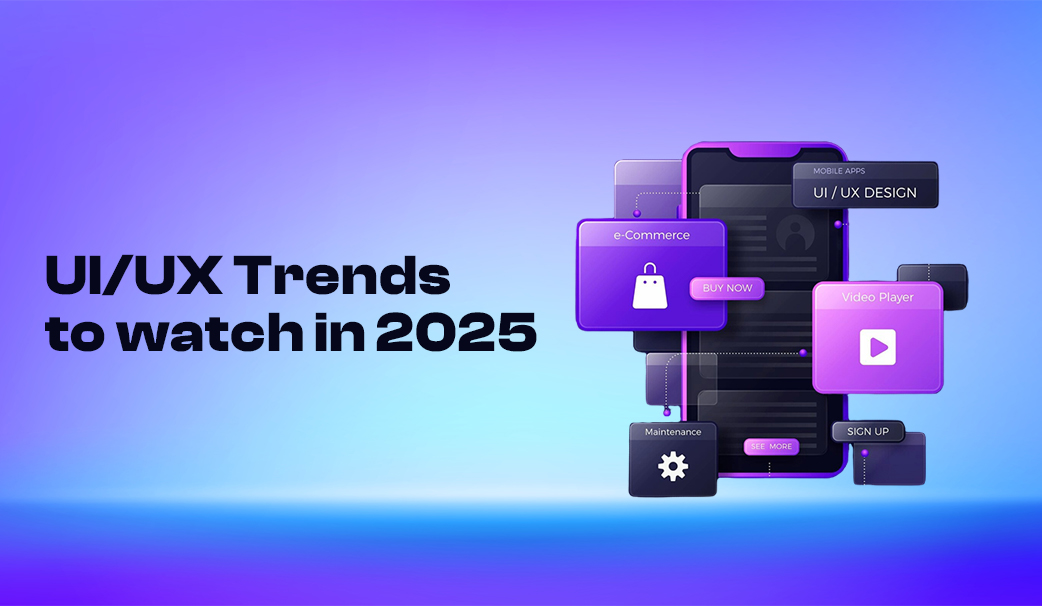
UI/UX design rapidly develops as technology changes and users modify design paradigms and approaches. Below are several UI/UX design trends specific to 2025 that will transform brand experience so that brands can have a competitive edge in user-centric environments. This article covers the best UI/UX trends to watch in 2025, together with a breakdown of how these trends define the future of design.
The age of generic experiences is fading into the past. By 2025, hyper-personalization will dominate UI/UX design, thanks to advanced AI and machine learning algorithms. This will enable designers to craft interfaces that automatically adapt to individual users' preferences in real-time, thus delivering bespoke content, layouts, and interactions.
For example:
This user-centered experience will ensure high user involvement and satisfaction.
Augmented Reality (AR) and Virtual Reality (VR) are no longer niche technologies. Both will enter the mainstream by 2025, changing consumer experiences in retail, education, real estate, and more. AR-enhanced product visualization and VR-powered virtual tours are prime examples of how these technologies are transforming user interactions.
Key applications:
These developments highlight the rising significance of immersive user interface design trends in 2025.
Micro-interactions are now becoming essential as subtle yet impactful elements in the design. They refer to very small animations or visual cues for providing feedback or to help users do tasks without much hassle. In 2025, these are expected to develop into the following:
These elements enhance the user experience (UX) by rendering interfaces more engaging and responsive.
In response to users' demands for ethical practices, sustainable design is projected to be a significant focus in 2025. Designers will prioritize:
Concurrently, inclusive design will tackle accessibility issues by:
These trends represent a greater commitment to making digital experiences universally accessible and eco-conscious.
Voice User Interfaces (VUIs) are on the rise with the increasing popularity of smart speakers and IoT devices. By 2025, voice commands will be integrated into apps and websites in a hands-free way, thereby providing accessibility benefits.
NLP advancements will allow for:
The growth of VUI underscores its role in shaping the latest UI design innovations.
Neumorphism, known for its soft, 3D-like design aesthetics, is evolving into Neumorphism 2.0 in 2025. This updated style combines the tactile appeal of classic neumorphism with improved usability. Expect designs with:
This form and function blend makes Neumorphism 2.0 a key contender in UI design trends for 2025.
Dark mode has been on the rise, and by 2025, it will be the norm for most applications. Beyond aesthetics, the dark mode offers practical benefits:
To remain competitive, designers must facilitate seamless transitions between light and dark modes while preserving brand consistency.
The significance of data-driven decision-making has resulted in the increasing prominence of interactive data visualization and user-friendly dashboards. By the year 2025, dashboards are expected to:
These advancements underscore the importance of rendering complex data both comprehensible and actionable.
The incorporation of 3D graphics and animations within user interface design is experiencing continuous growth. These elements not only augment visual appeal but also furnish context and depth to interfaces. In the year 2025, one can anticipate:
Such elements push the boundaries of conventional UI/UX design and make the user experience memorable.
No-code and low-code platforms are further accelerating the democratization of design. These platforms allow designers and developers to prototype and develop applications without extensive coding knowledge. By 2025, these platforms will:
This trend reflects the growing availability of UI/UX design tools.
The UI/UX trends to watch in 2025 emphasize user experience, innovation, and sustainability. From hyper-personalization to immersive augmented reality and virtual reality experiences, these trends represent the moving nature of design in a digitally first world. As brands embrace these developments, staying abreast of the latest UI design innovations will be critical in delivering meaningful user experiences.
1. What is the trend in UI UX 2025?
The main trends in UI/UX design for 2025 are hyper-personalization, AR/VR integration, sustainable and inclusive practices, advanced micro-interactions, and the appearance of voice user interfaces.
2. What is the trend in design in 2025?
Design trends for the year 2025 are basically centered on immersive experiences, 3D graphics, neumorphism 2.0, and data-driven dashboards, and a growing concentration on accessibility and sustainability.
3. What is the next big trend in UX design?
The future major trend in UX design will be the complete integration of artificial intelligence and machine learning to make user experience hyper-personalized and predictive.
